Steve Baker Demands Boris Publish a Freedom Plan

Steve Baker, the Deputy Chair of the anti-lockdown Covid Recovery Group (CRG) of Conservative MPs, has issued a rallying cry to the group’s members. The Sun has the story.
In an explosive rallying call to fellow members of the lockdown-sceptic Covid Recovery Group, the ex-minister blasted: “People are telling me they are losing faith in our Conservative Party leadership.”
The group represents dozens of Tory backbenchers who are worried about the side effects of long lockdowns.
Mr Baker urged those colleagues to make their concerns directly to Mr Johnson’s Commons enforcer, Chief Whip Mark Spencer.
In a bombshell note to MPs seen by the Sun, Mr Baker writes: “I am sorry to have to say this again and as bluntly as this: it is imperative you equip the Chief Whip today with your opinion that debate will become about the PM’s leadership if the Government does not set out a clear plan for when our full freedoms will be restored.”
He told them to demand “a guarantee that this strategy will not be used again next winter”.
The major intervention reads: “Government has adopted a strategy devoid of any commitment to liberty without any clarification about when our most basic freedoms will be restored and with no guarantee that they will never be taken away again.”
The action appears to have been triggered by key Government advisers going public with their view that lockdowns must continue well into 2021.
Mr Baker broke cover after Government scientist Jonathan Van Tam told this newspaper yesterday that lockdown measures could be in force until late spring.
And today controversial scientist Neil Ferguson said we could still be facing restrictions in the autumn.
Mr Baker raged: “Certain Government scientists have said that the current lockdown could last until late spring. There is no reason to think there will be any real resistance in Cabinet to the argument for greater and longer and more draconian restrictions on the public.
“This could be a disaster. Nothing seems more certain to break the public than giving hope before taking it away, and doing it repeatedly.”
And he signs off with a barely concealed warning shot: “I am sorry to be blunt but if we do not act now, events will become inevitable. For the good of the country please contact the Chief Whip.”
Katy Balls in the Spectator notes that Baker has diluted the implied threat to Johnson since the story broke. She thinks the intervention is more of a warning shot at this point than a full-blown threat.
Since the comments came to light, he has also tried to water down his comments – insisting Johnson still remains the only man for the job.
So, is Johnson’s leadership under threat? No. That seems premature. The third lockdown was overwhelmingly passed by MPs – with a comparatively small Tory rebellion compared to previous votes. The number of MPs willing to oppose the government on its lockdown strategy has in the short-term decreased. With the death toll on Wednesday alone at over 1,500, many lockdown sceptics plan to keep their powder dry for the time being. Rather than oppose immediate lockdown measures, they are turning their attention to the debate on how many need to be vaccinated before restrictions can be lifted.
Here Baker’s concerns are a sign of things to come. While the bulk of Tory MPs support the government’s approach for now – and are relieved there is finally a good news story to tell in the vaccination programme – the bulk are keen for restrictions to be lifted as soon as possible. Boris Johnson insists this is his wish too.
However, MPs worry that Johnson will be pushed by his scientific advisers and some cabinet ministers to keep restrictions in place for much longer than they believe is reasonable. In the parliamentary party, many see the point by which the vulnerable have been vaccinated as when restrictions go. They see spring as the point when many restrictions ought to be lifted and the summer the point by which there ought to be no restrictions in place. So far, Johnson has been reluctant to give a specific timeline. That position is going to become much harder to maintain as the weeks go on and discontent grows.
Stop Press: Sherelle Jacobs has a thoughtful piece in the Telegraph, arguing that there’s going to be a lot of moral and emotional pressure to go for Zero Covid over the coming months and lockdown sceptics need to be ready for the battle.
But what the lockdown-sceptics haven’t quite articulated is that, once again, the public has been persuaded into a lockdown based on a delusion. The myth of the first lockdown was that it would only have to last three weeks. The myth of this lockdown is that life can resume in spring. But restrictions are unlikely to be lifted until the summer at the earliest for a simple reason: it is not deaths but media headlines about overwhelmed ICUs that strike fear into the hearts of ministers. A cynic might argue we have just sacrificed half a year of freedom on the NHS altar to save the skin of the Tories.
Even with the vaccine rollout at full throttle, the risk of an overwhelmed NHS will not abate until the over-50s are vaccinated, ideally by May. Although the over-75s present the greatest mortality risk, Covid patients in intensive care have a median age of just 62, and under a third are aged over 70. So vaccinating those who might die from Covid will not end pressure on the health service. Paradoxically, a big bang reopening of society when the virus is still circulating may increase it.
But there is a prospect even worse than another six months of lockdown: another year of lockdown in an attempt to eliminate the virus entirely.
It is not difficult to see how a terrified population that has been fed guff about “defeating” the virus might be swayed by the Zero Covid argument. Particularly once they realise that “learning to live” with the disease once priority groups have been vaccinated still means accepting heightened vulnerability to mutations and Long Covid, with the endemic virus returning each year. It is also not hard to see how the Tories might see Zero Covid as the path of least resistance. Hyperparanoia about being booted out of office for letting the NHS fall over will increase the temptation to stamp out an unpredictable disease.
Worth reading in full.
A Senior Doctor Writes…
There follows a guest post by the senior doctor who contributes weekly updates on the state of the NHS to Lockdown Sceptics.
Yesterday the NHS Hospital Statistics Website released a large data packet summarising Covid related activity for the preceding month. Once again, Lockdown Sceptics has kindly asked me for an opinion about what we can deduce from the information provided. There is a lot of useful information in this packet – I apologise to readers if some of the following is a bit dense, technical and difficult to follow, but the devil is often buried in the detail – sometimes he is hidden there deliberately.
Before looking at the monthly summary, I will comment on the daily updates. These are less detailed but more up to date than the monthly figures.
Graph 1 shows the daily admission figures from the community for English regions expressed as a three-day moving average to smooth out the curves. It is clear that for the last week, admissions from the community in London, East England and the South East have been falling – very encouraging.
However, there have been recent uptrends in the Midlands and the North West. The falling rate in London and the South East is consistent with the ZOE app data which showed a downtrend in symptomatic people from about December 31st. Readers should note that the current lockdown began on January 6th. By that point admissions had peaked and were already on the downward slope. The effect (if any) of lockdown on hospital admissions will not be observable until at least January 16th. Nevertheless, the reduction in hospital admissions is being reported in the mainstream media as being a consequence of lockdown – I don’t think that view is supported by the evidence.
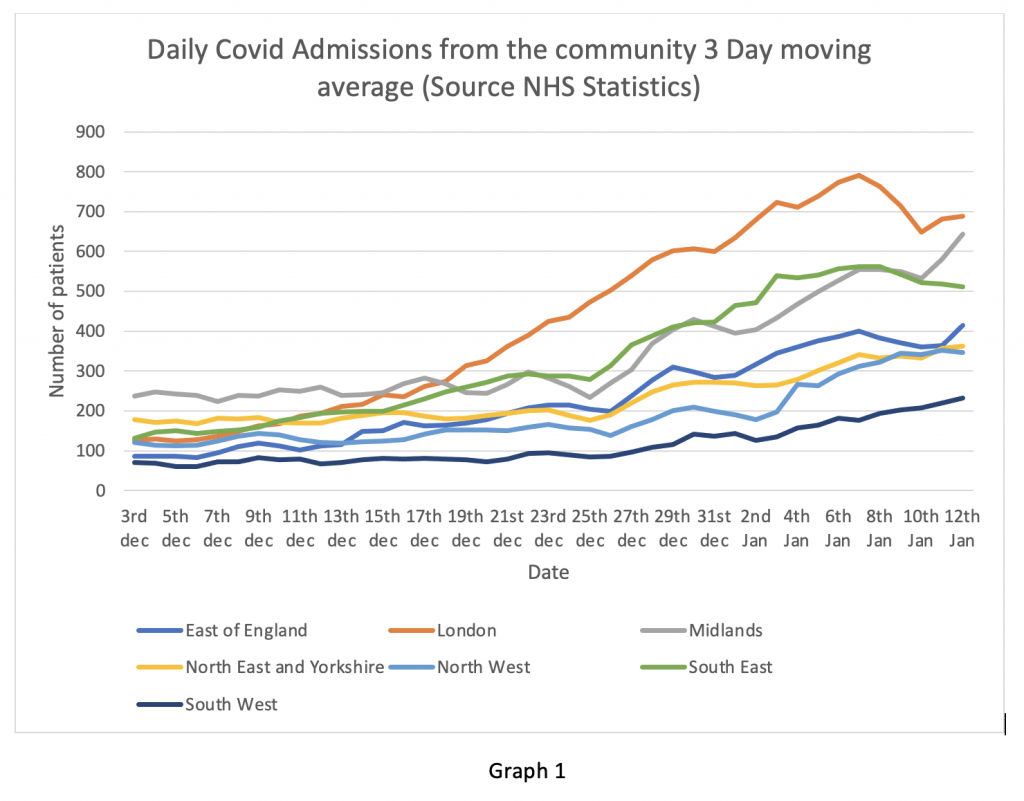
Next, the overall inpatient situation on Graph 2. Despite falling admissions from the community, the overall number of Covid patients in London remains flat. How can this be? I will explain later with data from the monthly summary packet.
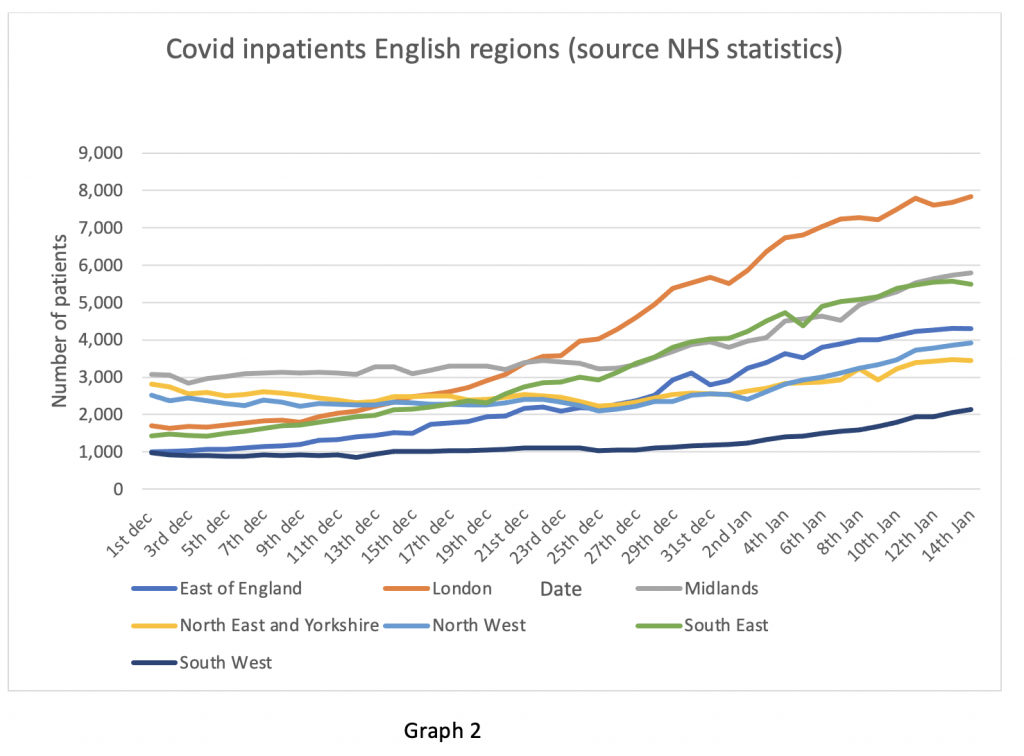
Finally, on the daily figures, the ICU bed occupancy data in Graph 3. This is the graphic of most concern in my opinion. ICU occupancy tends to lag inpatient admission by two to three days – this is the length of time for a patient to become ill enough to require intensive care according to the ICNARC ICU audit. Hence falling admissions do not immediately translate into falling ICU numbers. The angle of slope in London in particular is still on an upward trend. Some of this may be because London Hospitals are soaking up ICU admissions from the South East region, where local hospital capacity has been exceeded. ICU patients tend to stay a long time, so these numbers take a while to subside when the peak is reached. As far as ICU numbers are concerned the peak does not look like it has arrived yet in any English region. In particular the ICU numbers are still on an upward trend.
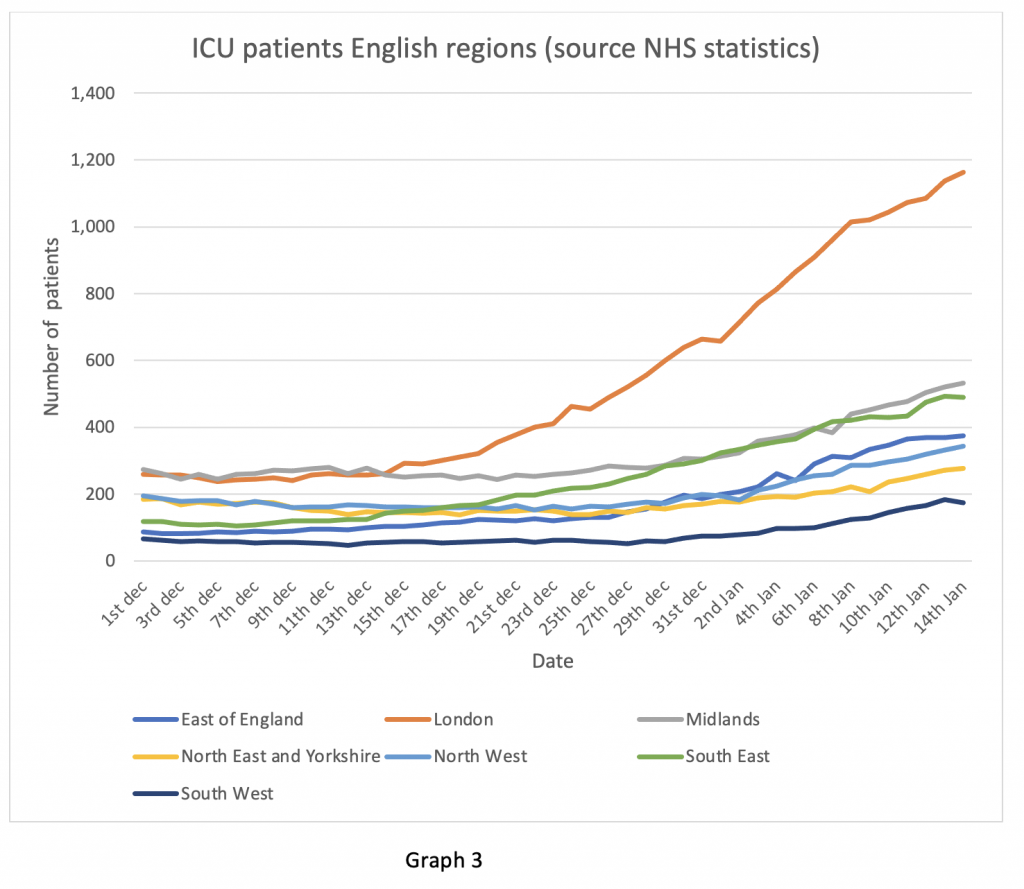
The monthly data packet contains a lot of information which I will comment on in the next few days. It has been illuminating in shedding light on several questions which were troubling me. I propose to address just two this evening.
Firstly, the issue of discharging Covid patients from Hospital. Discharging elderly patients in winter is an annual problem. Patients who cannot be discharged are unkindly referred to as “bed blockers”. The usual reasons are that they are too frail to be sent home alone if there is no-one to look after them, or not well enough to be accepted back by a care home. This problem is worsened by care homes being reluctant to accept Covid patients in view of what happened in the spring, when large numbers of patients with Covid were discharged into care homes causing several outbreaks of infection. An article in the Financial Times recently highlighted that insurers of care homes were reluctant to cover them for outbreaks of COVID-19 and that this was delaying hospital discharges.
Graph 4 shows the effect that delayed discharge has on total bed occupancy. This is a complicated compound graph with two separate Y axes, so I will explain what it means. First, consider the first part of the X axis Dec 1st to Dec 9th. During this time, the combined daily admissions and hospital Covid diagnoses depicted in the vertical bars was roughly equal to the daily discharges on the blue line (left hand Y axis). Hence the total number of Covid inpatients on the yellow line was roughly stable.
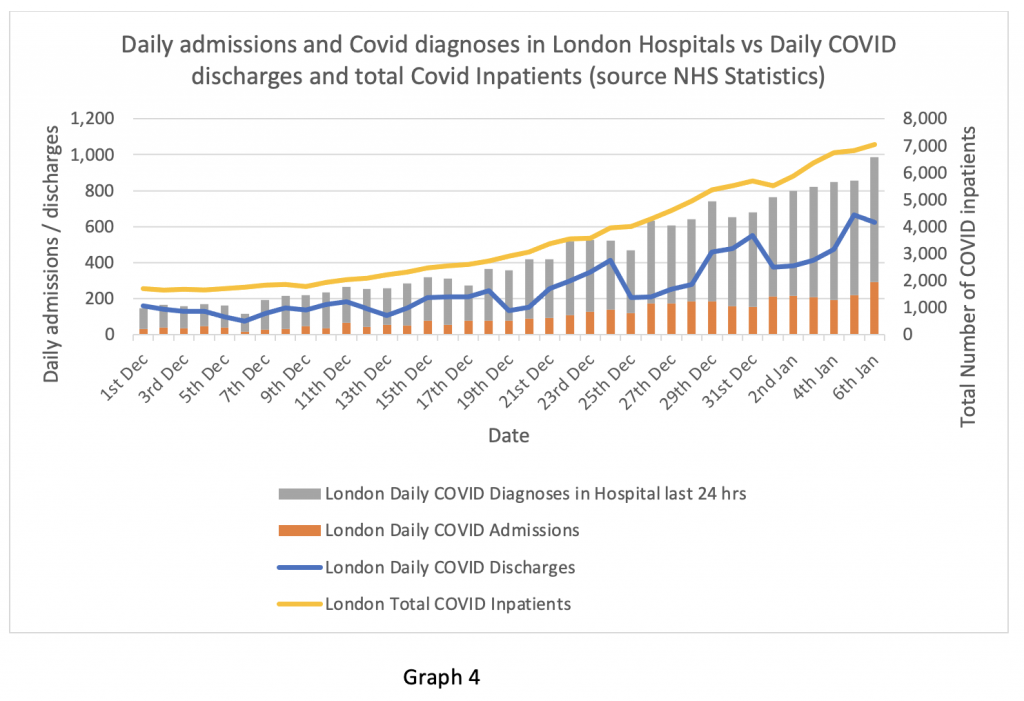
From December 10th onwards, daily admissions started to exceed discharges and this trend has worsened as the graph proceeds through December into January. As a consequence, the total number of inpatients on the yellow line (right hand Y axis) continues to rise. Readers should note that the monthly figures are only presented up to January 6th, so as of this data packet the admissions downturn on January 7th is not yet visible.
This is clearly a major problem. Although admissions may be falling, the total number of inpatients is still rising because of failure to discharge. In London, the Nightingale hospital has reopened for ‘step down’ patients (not ICU patients as in the spring). It remains to be seen how successful that will be, bearing in mind that shortage of staff (not bed capacity) was the rate-limiting problem in the spring. Elsewhere, some imaginative and intelligent steps have been taken such as utilising spare hotel capacity to place convalescent patients – an affordable and practical solution, often used in the United States.
Now here is one devil. We know hospital discharge is always a problem in the winter. It was entirely predictable that this would be an issue in a ‘second surge’ of COVID-19. A predictable risk, with no plan to deal with it. I wonder why there was no plan? And who is taking the responsibility for the lack of one?
Next, I turn to the issue of age stratification of Covid patients. A few days ago, I saw an article on the BBC news by the reporter Hugh Pym. He visited Croydon University Hospital and reported that there were “many more younger patients” affected by Covid in the winter than in the spring. The monthly data packet does contain age stratified figures for hospital admissions. I thought I should examine these.
First, I looked at the data for England as a whole. It is recorded that 37% of the Covid patients admitted from March 20th to April 30th were aged between 18 and 64. Between November 27th and Jan 6th, 39% of patients were in this younger age bracket – a very modest increase and certainly not “many more” younger patients.
The age bracket 18-64 is quite wide and it could be possible that the distribution is skewed to the younger part of that group. Therefore, I looked at the reported death statistics across the spring and the winter up to Jan 1st 2021, which are much more clearly age stratified. Between March and May 2020 there were 45,511 reported deaths from Covid, of which 3,020 were aged between 0 and 59 years (6.64%). In the period November to January 1st, there were 20,370 deaths of which 1,073 were registered as COVID deaths – 5.26%. So, in fact there were proportionally fewer Covid deaths in the younger age group in the winter than in the spring reported up to January 1st.
Bearing in mind that death registration can lag date of death by up to two weeks, I looked at the ICNARC ICU audit data comparing cohorts of patients admitted up to August 31st and after September 1st till January 6th. Age at admission to ICU was actually older in winter than spring: Mean average 60.2 years in the winter, median 62 years, compared to a mean of 57.8 and a median 59 of years in the spring.
How can we explain this discrepancy? There do not appear to be “many more” younger patients suffering from Covid in hospital this winter. In fact, the official figures suggest that there are proportionally fewer very sick younger patients and fewer deaths in this age group than in the spring. If that is correct, why did Hugh Pym report precisely the opposite on the national news?
Perhaps someone from the BBC could contact Lockdown Sceptics to explain what I’m missing in this data? Surely, the lavishly taxpayer funded BBC, with hordes of researchers, fact checkers and expensive journalists, must be more accurate in its interpretation of the data than one private individual with a laptop and an internet connection. Maybe they have access to more up to date information than I can see. I would be most grateful to be shown the errors in my calculations and will be happy to be corrected if I have misinterpreted the figures.
Finally, having looked at the recent past (monthly data summary) and the present (or as close to it as we are permitted to see by the daily figures), I will turn to the future.
The drop off in community symptoms reported on the ZOE app and reflected in the drop in hospital admissions in London, the South East and East of England is certainly welcome. However, it begs the question of why further lockdown restrictions were necessary on January 6th when the community transmission appeared already to have peaked.
On the other hand, the rise in admissions in the Midlands and the North West is of concern. In particular, the rising trend in ICU admissions is worrying. These are likely to continue to rise for several days at least. An issue that may not be obvious to the non-medical reader is that there are substantial differences between the hospital geography of London and the rest of the UK. A densely populated metropolis like London has several large hospitals in close proximity to each other, all with substantial surge capacity to deal with peaks of excessive demand. Mutual support between hospitals is relatively easy to arrange and co-ordinate, so patients can be transferred between hospitals to manage areas of high stress.
Other regions of England are not so fortunate. Even the larger urban areas of the Midlands and Greater Manchester have fewer large hospitals than London. Transfer of patients between hospitals is more problematic. ICU capacity in particular is not rapidly expandable as it is in the capital and surge resilience, particularly in more rural areas, is lower. This could be a serious problem in the coming days. I hope NHS England has a workable plan in place, but I smell sulphur.
What’s Behind the Pressure on Hospitals?

The guys at AdapNation have put together a handy infographic using the information they’ve gathered from NHS insiders and other sources. They explain:
This explains the discordance between the lower-than-normal bed use and ambulance stats vs the NHS alarm bells.
I had the insightful opportunity to interview an NHS employee involved in the logistics of a busy England hospital today.
The message was clear – they are insanely busy. It’s a pressure cooker environment beyond the high pressure they experience every winter.
However, the reason is not a single headline. It doesn’t marry with the raw hospital data. And it certainly is not due to an abnormal excess of acute respiratory infections.
Check out the image [above] that summarises the issues NHS Hospitals are currently facing.
This matches the experience and insights we have received directly from Dr. Malcolm Kendrick, Dr, Clare Craig, various anonymous NHS Hospital workers and a couple of GP staff too.
Worth checking out.
Stop Press: Lockdown Sceptics contributor Jonathan Engler has summarised much of the same data in a Twitter thread.
Government Quietly Admits PCR False Positive Problem
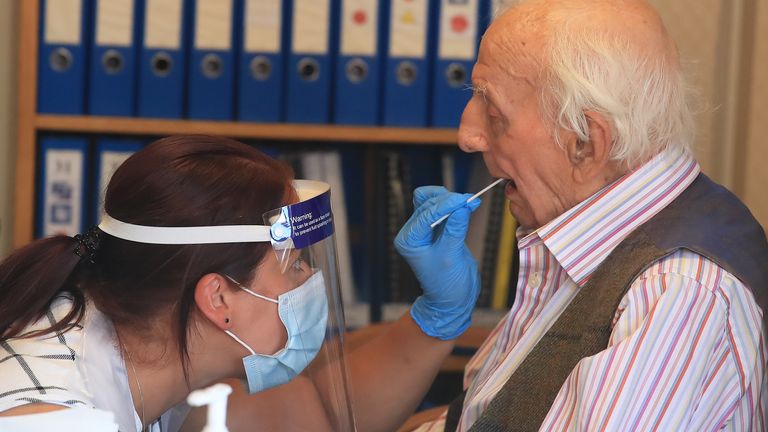
There has been understandable concern about the plans, leaked to the Telegraph, to discharge care home residents from hospitals again without a negative PCR test. But is this in fact a belated admission from the Government that PCR tests keep on giving positive results long after the patient ceases to be unwell or contagious? From the Telegraph:
Coronavirus hospital patients can be discharged into care homes without being tested under draft Government guidelines leaked to the the Telegraph.
Care providers have said they are “deeply worried” about the latest proposed rules, which advise clinicians to release patients without requiring them to have a test 48 hours before discharge if they have no new virus symptoms and have isolated in hospital.
For the first time, the Government appears to acknowledge that people could test positive for Covid but not be infectious, suggesting “it will be appropriate for them to move directly to a care home from hospital… because we now know they do not pose an infection risk to other residents in a care home”.
It describes this sub-group as “immunocompetent and with no new symptoms” even if they are within 90 days of their initial symptoms or positive test result.
The top-rated comment under the Telegraph article, from Stephen Jackson, spotted the significance:
The story is misleading.
The real reason for this policy is that PCR tests will continue returning a positive result for several weeks after a person has recovered from Covid and is no longer infectious. This is because PCR analysis will trigger a positive result even if tiny fragments of dead virus are still present/shedding in the nose or throat. If you have a policy of not discharging patients until they’ve tested negative it traps perfectly well and non-infectious people in hospital for weeks on end. This was well documented in South Korea in April-May.
The NHS has to free up beds without risking a care home debacle but I suspect nobody in the health profession wants to admit that PCR tests give so many false positives. That would obviously undermine public confidence in Covid test results and compliance with self-isolation orders. So they’ve had to come up with an alternative policy involving a two-week isolation period before being discharged and perhaps with a deliberate but hushed-up decision not to re-test the patient at that point (knowing it might give a false positive, trapping the patient in hospital again).
PHE Study Confirms Infection Gives Immunity

A new study from Public Health England has confirmed that infection with SARS-CoV-2 confers strong immunity to the virus. The Times has the details.
The PHE findings are the result of the most comprehensive study into reinfection rates so far. Previous illness provided about 85% protection against both asymptomatic and symptomatic reinfection, researchers said after following thousands of people who caught the virus in the spring.
Although they found that a small number among the group did get infected twice, typically they suffered a milder form of the disease.
With an estimated one in five having been infected, the findings, based on a study of 21,000 UK healthcare workers, suggested that herd immunity could already be slowing the course of the pandemic. However, scientists warned that they still did not know how long immunity lasted.
“What that’s saying to us is that prior infection looks as good as the vaccine, at least at this time interval, which is very good news for the population,” said Susan Hopkins, Deputy Director of the National Infections Service at PHE. “It will help alongside the vaccine to give a level of immunity and protection that will start to reduce transmission.”
The research by PHE followed 6,600 clinical staff infected in the first wave, along with 14,000 who had remained healthy, regularly testing them to see whether they were subsequently positive.
By late November there were 318 infections among the 14,000 and at most 44 reinfections among the 6,600. Most of those cases were mild and showed no symptoms.
There was some uncertainty about the reinfection number, which may have been even lower. The scientists said they could not exclude the possibility that in some cases they were picking up evidence of the first infection.
Although the Pfizer vaccine has a headline efficacy rate of 95%, that figure is based on symptomatic infections alone, so the mildest cases were ignored.
Professor Hopkins said the best way to think of it was that immunity from infection was as good as, or better than, a vaccine.
“The immunity gives you similar effects to the Pfizer vaccine, and much better effects than the AstraZeneca vaccine, and that is reassuring for people,” she said. Two doses of the Oxford-AstraZeneca vaccine offer 62% protection.
However, she said it was not a licence to ignore social distancing. “It does seem that new infections can come. You can definitely get reinfected after primary infection,” she said Even in some of those with asymptomatic infections, they found they were shedding a lot of live virus — implying they were infectious without knowing it. But, she, added: “The risk of severe disease is extremely low… even if you are infectious, it is likely to be for a very short period of time.”
“Overall I think this is good news, it allows people to feel that their prior infection will protect them from future infections, but at the same time it is not complete protection and therefore they still need to be careful when they’re out and about,” she added. “I am strongly encouraged that people have immunity that is lasting much more than the few months that was speculated before the summer.”
Frustratingly, PHE has not yet published the study so we cannot look at the details of how infection was diagnosed and what symptoms they had, though the indications in the reports that reinfections were mild or even false positives (picking up fragments from the previous infection) is in line with other evidence to date.
Stop Press: A Lockdown Sceptics reader emailed PHE to ask some questions and find out where the study was published. They quickly got back to him to say: “The paper will be uploaded to a preprint server and made public in the next day or so. You will be able to find a detailed explanation of the methodology there. Apologies for the delay.”
Toby Replies to Neil O’Brien MP

There follows a guest post by Toby.
Yesterday, I was attacked on Twitter again by the Conservative MP Neil O’Brien – it’s becoming a daily occurrence. This one involved an obsessive degree of offence archaeology. He even listened to last week’s London Calling podcast, carefully noting down any deviations from Covid orthodoxy. Julia Hartley-Brewer had the temerity to ask him why he was trolling people on Twitter instead of looking after his constituents, at which point he immediately started attacking her. All, it seems, to demonstrate his unwavering loyalty to Tory High Command and their forever lockdown policy. As one regular contributor to Lockdown Sceptics observed:
Whatever the era, whatever the epoch, it seems that the Neil O’Brien’s of this world are forever destined to be the first sent into battle. Stolid, inert, expendable; the mediocre soldier, sacrificed in order that the strength of the enemy’s defences might be tested. If he’d have been at Ypres in 1914 you’d have put money on him being the private who’d have been ordered to stick his head up above the trench line just so the commanding officer could get a sense of where the enemy fire was going to come from. He’d have done it eagerly, too, with real patriotic fervour (“How high, Sir! How high!!”).
I decided to respond with a long Twitter thread of my own. For those of you not on Twitter – and who can blame you? – I’ve reproduced it below.
Attacks on Lockdown sceptics – and me in particular – have ratcheted up recently, with one of the most aggressive critics being the Conservative MP @NeilDotObrien. I thought it was time to compose a reply.
On Monday he wrote a piece for @ConHome entitled “Trumpism in Britain. It’s time to call out those in the media who cynically feed the cranks, rioters and conspiracists” in which he compared lockdown sceptics to QAnon conspiracy theorists and anti-vaxxers.
He compared lockdown sceptics to QAnon conspiracy theorists and anti-vaxxers and urged media companies “to practice some basic hygiene about whose views they are promoting”, i.e. no-platform the sceptics.
But arguing that lockdowns cause more harm than they prevent is not comparable to arguing that the US government is run by a cabal of Satan-worshipping paedophiles or that vaccines contain microchips inserted by Bill Gates to control our minds.
In fact, there is a growing body of research showing that quarantining whole populations, the healthy as well as the sick, is a sub-optimal policy response to this pandemic. @AIER published a round up of some of the best here
Yesterday, @the_brumby linked to “30 published papers finding that lockdowns had little or no efficacy (despite unconscionable harms)”
The problem with arguing that lockdown sceptics have “blood on their hands” – an increasingly popular trope – is that it takes it for granted that lockdowns are effective at reducing overall mortality and that is precisely the issue being debated.
This is an important public debate to have, both because it helps us assess the present government’s management of the pandemic and because it will help us prepare better for the next one.
A Conservative MP should not be urging media companies to suppress one side in that debate, particularly as the 2019 Conservative manifesto reaffirmed the party’s commitment to free speech.
In his latest Twitter thread, @NeilDotObrien accuses me of having deleted all my tweets from last year because I’m embarrassed about having got so many things wrong about the virus.
In fact, I installed an app last week that deletes all tweets more than a week old. This was in response to Twitter’s increasing intolerance of people who challenge liberal orthodoxies, including Covid orthodoxy. I would advice other dissenters to do the same.
The app won’t protect you from Twitter’s internal offence archaeologists, but it will make it harder for censorious, left-wing activists to bombard the company with vexatious complaints in the hope of getting you banned. The app is here.
@NeilDotObrien also selectively quoted from various posts I’ve done for the @Telegraph. For instance, he quoted me saying this: “we were told… the number of infected people was on the rise again… the rise was due to a combination of increased testing and false positives.”
Here are the two paragraphs he got that quote from. See what he did there?
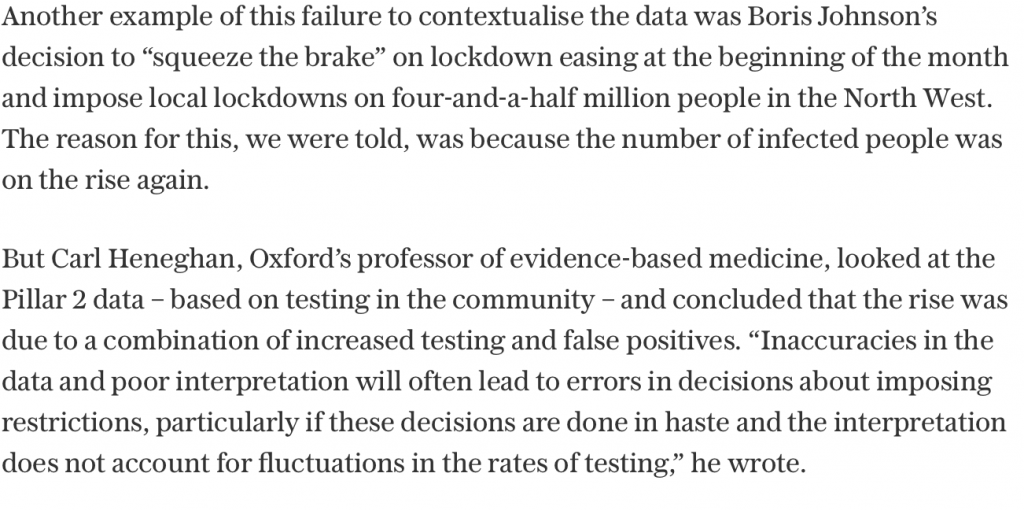
Of course, I’ve got some things wrong about the virus, such as predicting there wouldn’t be a resurgence of infections this winter. I put my hands up to that on @Newsnight when @maitlis asked me about it.
But I don’t think lockdown sceptics have been consistently more wrong about the virus than lockdown advocates. For instance, the @WHO initially estimated the IFR of COVID-19 was 3.4%. We now believe it’s ~.25%.
A study by researchers at UCLA and IHME compared the accuracy of various models predicting COVID-19 mortality and the models produced by Imperial were judged to have far higher rates of error than the others — always erring on the side of being too high.
After the government unveiled its “graph of doom” showing deaths could climb to 4,000 a day absent more restrictions, it was reprimanded by the @UKStatsAuth.
And how much trust can you place in the advice of public health authorities to wear masks when the initial advice was that they were ineffective outside healthcare settings?
Yes, lockdown sceptics have got some things wrong, too, but I think we’ve provided an important counterweight to the largely one-sided reporting of the broadcast media, particularly the BBC.
The daily sceptical blog I put together with a team of other, like-minded journalists has published some important stories, such as this one by a Lighthouse Lab whistleblower.
And this one by a disillusioned worker at a pop-up testing facility in Salisbury.
And this review of the code powering Neil Ferguson’s epidemiological model by Mike Hearn, formerly a senior software engineer at @Google.
It’s also published some terrific pieces of writing, such as this piece on conspiracy theories by Sinéad Murphy, a philosophy lecturer at Newcastle.
And this “Postcard From Argentina” by a social science professor.
And this tribute to all those who’ve been laid low by the collateral damage caused by the lockdowns by Freddie Attenborough, a sociology lecturer.
Lockdown Sceptics will continue to publish these dissenting voices and continue to challenge the official narrative being pumped out by the government and the BBC. I don’t think that’s “dangerous”; I think politicians trying to smear and silence dissenting voices is dangerous.
Blaming the high daily death tolls on lockdown sceptics is a variant of blaming the public. If only ordinary people had been more compliant, we wouldn’t be in this pickle. But thanks to lockdown sceptics like @toadmeister, @allisonpearson, @ClarkeMicah, @JuliaHB1 and @LozzaFox…
Nothing to do with the lack of PPE, failure to create dedicated hospitals for Covid patients, spunking tens of billions of pounds on a not-fit-for-purpose Test and Trace programme, building the Nightingales but not recruiting or training enough healthcare workers to staff them…
…decommissioning the Nightingales, failing to eliminate in-hospital infections and the ongoing scandal of secondary transmission in care homes… no. It’s all the fault of the general public and the “conspiracy theorists” who’ve led them astray.
Time to take the mote out of your eye @NeilDotObrien and take a look at the politicians you’re so eager to curry favour with. Lockdown sceptics won’t be your scapegoats. //Ends
Stop Press: Julia H-B did a bit of offence archaeology of her own and discovered that Neil O’Brien wasn’t that keen on lockdown restrictions himself back in July. Fancy that!
Norway Says Very Frail People Should Not Receive Covid Vaccine: “Side Effects May Have Led to Deaths”

Norway has determined that vaccinations may be contributing to deaths in the very frail elderly and changed its advice. Trondheim24 has the story (via Google translate, H/T Alex Berenson).
More than 25,000 Norwegians have been vaccinated with the first dose of the coronary vaccine from Pfizer and Biontech since Christmas. On Friday, the first dose of the new Moderna vaccine will be given.
So far, the Norwegian Medicines Agency has assessed 29 adverse reaction reports after the COVID-19 vaccination. 13 of these had a fatal outcome, shows a new report from the Norwegian Medicines Agency.
A total of 23 deaths have been reported in connection with vaccination, but so far only 13 of these have been assessed. The other deaths are under treatment. Common side effects may have contributed to a serious course in frail elderly people, the Norwegian Medicines Agency reports.
All the deaths have occurred in frail, old patients in nursing homes. All are over 80 years old and some of them over 90, according to NRK.
The reports may indicate that common side effects from mRNA vaccines, such as fever and nausea, may have led to deaths in some frail patients, says chief physician Sigurd Hortemo in the Norwegian Medicines Agency.
As a result, both the National Institute of Public Health and the Norwegian Medicines Agency have changed the corona vaccination guide with new advice for this group.
If you are very frail, you should probably not be vaccinated, said subject director Steinar Madsen in the Norwegian Medicines Agency at a webinar on coronary vaccine for journalists on Thursday.
He emphasises that these cases are rare, and that many thousands of frail people have been vaccinated without a fatal outcome.
This side-effect of possible hastening of death among the very frail is not welcome news when the Government is relying on vaccination to reduce the death toll from the virus, which is concentrated amongst the frail elderly. It will be interesting to see whether any other health agencies come to similar conclusions and their governments follow suit.
Stop Press: Initial data from vaccination frontrunner Israel suggests that the Pfizer vaccine reduces infections by around 50% 14 days after the first shot. The Times of Israel has more.
Initial data from Israel’s vaccination campaign shows that Pfizer’s coronavirus vaccine curbs infections by some 50% 14 days after the first of two shots is administered, a top Health Ministry official said Tuesday, as the country’s serious COVID-19 cases, daily infections and total active cases all reach all-time peaks.
Sharon Alroy-Preis, head of the Health Ministry’s Public Health Department, told Channel 12 News that the data was preliminary, and based on the results of coronavirus tests among both those who’ve received the vaccine and those who haven’t.
Other, somewhat contrary data was released by Israeli health maintenance organizations Tuesday evening. Channel 13 News said that according to figures released by Clalit, Israel’s largest health provider, the chance of a person being infected with the coronavirus dropped by 33% 14 days after they were vaccinated. Separate figures recorded by the Maccabi health provider and aired by Channel 12 showed the vaccine caused a 60% drop in the chances for infection 14 days after taking the first shot.
Each of the HMOs compiled the data from some 400,000 patients they treated (800,000 in total).
The cause for the discrepancy between the studies was not immediately clear.
With Pfizer’s phase 3 trials only checking some 40,000 people, and given Israel’s world-leading vaccination campaign, the data could be some of the best on-the-ground indication yet of the vaccine’s efficacy.
Stop Press 2: The Guardian reports that Pimlico Plumbers, a large London plumbing firm, plans to rewrite all of its workers’ contracts to require them to be vaccinated against coronavirus. There may be legal issues, some lawyers have said.
Can Rogue Covid Police Officers be Sued?
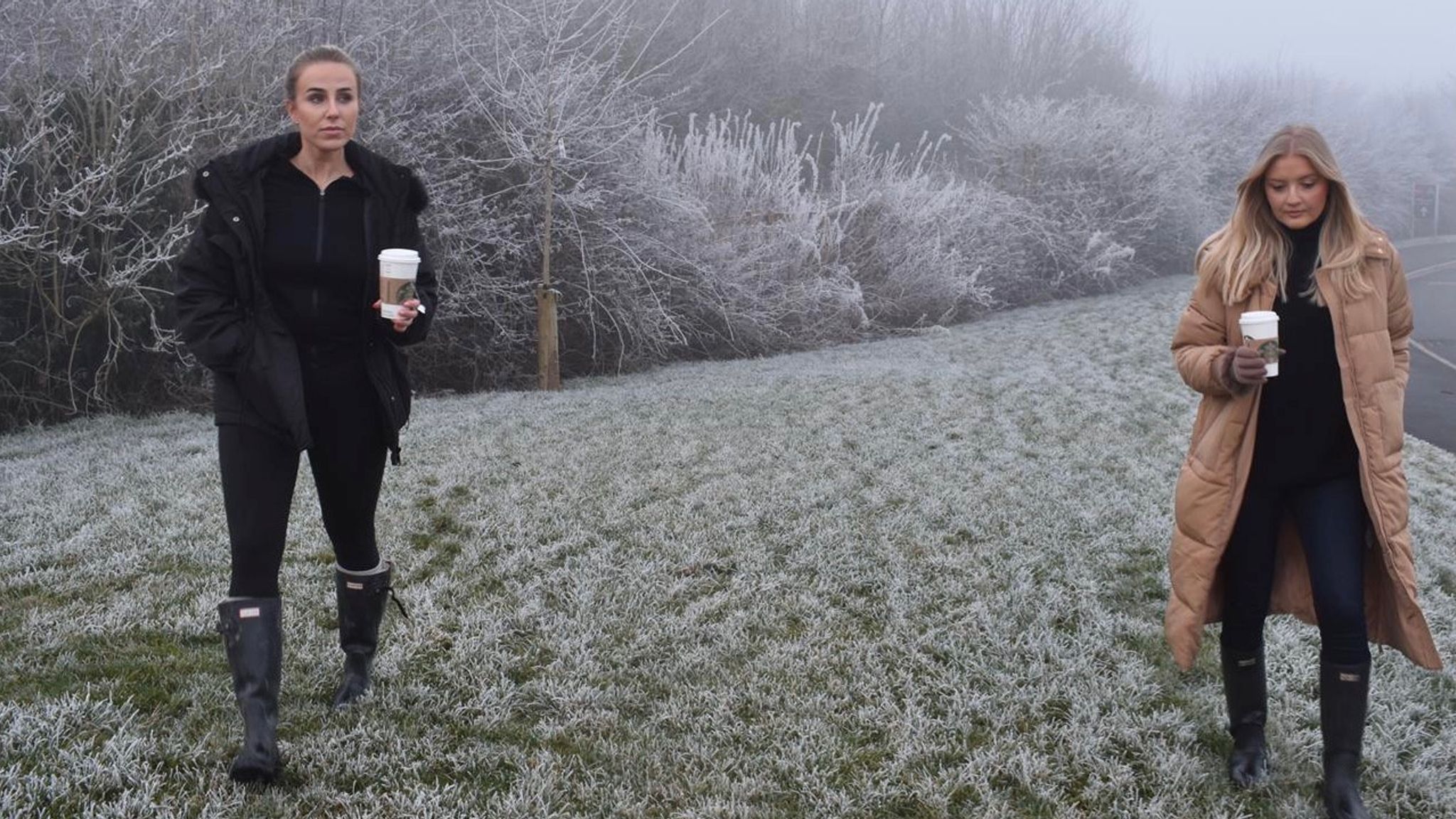
Our legal eagle, Dr John Fanning, Senior Lecturer in Tort Law at the University of Liverpool, answers a Covid legal question posed by a reader.
The myriad incidents of what might charitably be described as ‘police overreach’ are among the most unedifying spectacles of the COVID-19 crisis. The chief constable who threatened to deploy police officers to search people’s shopping trolleys to check that they were purchasing only ‘essential’ items. The man with a legitimate exemption from the requirement to wear a face mask escorted under threat of arrest out of a supermarket in Oldbury. And most recently, Derbyshire Police’s heavy-handed treatment of Jessica Allen and Eliza Moore as they enjoyed a socially-distanced stroll and a cup of tea. A year ago, these incidents would have been the workings of dystopian fantasy or the conceit of black comedy. No longer, it seems. As Lord Sumption pointed out in a recent lecture, the police have, at various points in this crisis, “substantially exceeded even the vast powers that they have received”.
All this raises questions about police liability when they get things wrong. The problem is that successful claims for negligence depend on there being proof of damage, such as personal injury. In a recent Supreme Court decision, police officers who injured a passer-by while effecting the arrest of a suspect were liable for her injuries. In all of the examples given above, however, the police apologised for overstepping the mark and, where relevant, cancelled any fines issued under the Regulations. So, no harm done – or at least not enough to raise a question of negligence.
The most likely source of civil dispute against the police at present probably lies in the tort of false imprisonment. This entails a complete restriction of a person’s freedom of movement without any legal authorisation. To use the reported details of Ms Allen and Ms Moore’s case as an example (although I do so with caution because I am not privy to all the facts), it is arguable that the seven police officers who surrounded the two friends imposed a constraint on their freedom of movement at least for a short period of time. The question is whether they had legal authorisation to do so. According to paragraph 2 of Part 1 of Schedule 3A to the Health Protection (Coronavirus, Restrictions) (All Tiers) (England) Regulations 2020/1374, a person is permitted to take exercise outside in a public outdoor place with one other person who is not a member of his/her household. By the letter of the law, it seems that Ms Allen and Ms Moore did nothing wrong and the police should have allowed them to continue their walk.
The reason they did not, it seems, is because the two friends were five miles away from their respective homes (and therefore not “local”) and were each carrying a cup of peppermint tea (and were therefore having a “picnic”). Yet the requirement to “stay local” is mere guidance, not law – it is a product of “legislation-by-press-conference” which has become an enduring theme of this crisis. And the idea that ‘two teas make a picnic’ is worthy of a stage farce. It is true that going for a picnic in the conventional sense does not constitute a “reasonable excuse” to be outside the place where one lives. But there is nothing in the rules which prohibits the consumption of food or drink during the course of legitimate exercise. Presumably, as long as one is doing star jumps at the material time, one can lawfully eat sandwiches, crisps and pork pies in the park while someone who is not a member of the same household swigs lemonade between sit-ups. The problem is that there has been a troubling conflation of legal rules and generalised advice or recommendations in recent weeks which risks undermining the rule of law. Small wonder that police officers, who are not lawyers and must navigate tempestuous legal seas, are struggling at times to delineate the limits of their powers.
A reader of this blog has asked whether a police officer would be personally liable for any harm he/she causes a person to suffer (e.g. through negligence, false imprisonment, and so on) and therefore required to pay damages out of his/her own pocket. In practice, the answer is no: the chief constable of the relevant police force would normally be vicariously liable for the officer’s tortious conduct as his/her “employer”. Vicarious liability is a rule of responsibility by which employers answer and pay for the injury, loss or damage occasioned to third parties by their employees. It is true that the employer can later seek an indemnity from its employee but this rarely happens. The rationale for this is that employers have “deep(er) pockets” – that is, more resources – from which to pay compensation to injured parties. This is not to say that there are no ‘internal’ consequences for individual police officers (such as disciplinary action), nor does it rule out the possibility of prosecution for criminal offences.
Another Lockdown Tragedy
A reader has got in touch to tell us of how lockdown has affected someone they know:
I heard today that my cousin’s 50-something wife – whose chemo for breast cancer was halted during the first lockdown – was reassessed today with a view to starting up the treatment again. They told her that it’s now spread too far and she won’t have long, so there’s no point in restarting the chemo. Still, at least lots of 80-somethings will get a few more years…
What’s more, she felt that she couldn’t tell her mum in person because she didn’t want to get in trouble, so she phoned and I can’t imagine how that call went.
Why is this sort of thing happening? What is the end goal, do you think? Is it about control or to become a communist state? To hit CO2 targets? I just don’t understand how these rules have come to pass that are so ruinous to peoples lives. Why doesn’t anyone listen to what the evidence shows?
Round-up
- “Regulator refuses to approve mass daily Covid testing at English schools” – Guardian report that the MHRA has refused to green-light the Government’s mass testing programme in schools using Lateral Flow Tests because of the risk from their supposedly high rate of false negatives (in fact mostly based on a misplaced faith in the PCR test)
- “The truth about the COVID-19 vaccine” – Watch Dr Simone Gold from American Frontline Doctors offer her thoughts on treatments and vaccines for COVID-19
- “The unpersoning of a lockdown critic” – Jake Welch in Conservative Woman tells the sorry tale of Michael Wendler, a German pop singer who was cancelled when he compared lockdown to a concentration camp
- “Leaders Need to Harness Aristotle’s Three Types of Knowledge” – Roger L. Martin, Richard Straub, and Julia Kirby in the Harvard Business Review take a philosophical look at what went wrong in 2020
- “Children and young may be left to catch Covid in future, says PHE head” – Mary Ramsay, PHE’s head of immunisation, comes out as an unlikely focused protection proponent when she tells MPs: “We may need to accept, if the vaccine doesn’t prevent transmission, that we’re going to protect the people who are really vulnerable … but we allow the disease to circulate in younger people where it’s not causing much harm”
- “My speech during the debate on COVID-19, January 12th 2021” – John Redwood bringing a sceptical voice to Parliament
- “What Happened to the Mental Health Crisis among Younger People?” – Mental health researcher Dr Niall McCrae in Areo looks at what’s causing poor mental health in young people
- “Patient ‘safety’ checks are causing deadly vaccination delays” – Peter Furness in the Spectator has seen the immunisation programme from both sides and is exasperated by the excessive safety protocols imposed from the top with no thought as to how to improve throughput
- “There will never be a ‘normal’ again” – William Parker in Bournbrook fears there may be no going back to a world where we’re not ruled by public health dogma
- “A Pandemic Reading List for Left, Right, and Libertarians” – Jeffrey A. Tucker on AIER offers some suggestions of books that show how it should have been done
- “Mass population screening for SARS-CoV-2 and false positives – why Liverpool shows we have a problem” – Letter from Lockdown Sceptics contributor David Cook in the BMJ
- “Vaccine success is on the brink of transforming the lockdown debate” – Fraser Nelson in the Telegraph with some optimism
- “Brazilian Covid variant may infect people who have recovered from virus” – Fears over another new variant – this is going to be a recurring theme – but hard data is sparse
- Brilliant sum-up of the Great Reset here – not that we believe in it, you understand
Theme Tunes Suggested by Readers
Three today: “Freedom come, freedom go” by The Fortunes, “Behind the Mask” by Michael Jackson and “I’m So Tired Of It All” by Merle Haggard.
Love in the Time of Covid

We have created some Lockdown Sceptics Forums, including a dating forum called “Love in a Covid Climate” that has attracted a bit of attention. We have a team of moderators in place to remove spam and deal with the trolls, but sometimes it takes a little while so please bear with us. You have to register to use the Forums as well as post comments below the line, but that should just be a one-time thing. Any problems, email the Lockdown Sceptics webmaster Ian Rons here.
Sharing Stories
Some of you have asked how to link to particular stories on Lockdown Sceptics so you can share it. To do that, click on the headline of a particular story and a link symbol will appear on the right-hand side of the headline. Click on the link and the URL of your page will switch to the URL of that particular story. You can then copy that URL and either email it to your friends or post it on social media. Please do share the stories.
Social Media Accounts
You can follow Lockdown Sceptics on our social media accounts which are updated throughout the day. To follow us on Facebook, click here; to follow us on Twitter, click here; to follow us on Instagram, click here; to follow us on Parler, click here; and to follow us on MeWe, click here.
Woke Gobbledegook

We’ve decided to create a permanent slot down here for woke gobbledegook. Today, Janice Turner in the Times contemplates what will become of Sex and the City by the time the activists have finished with it.
Last week, listlessly seeking distraction from doom, I found myself watching the first four episodes of Sex and the City back-to-back in a happy trance. Friends meeting for brunch! Cocktail hour, fancy shops, city streets full of purposeful people, frivolous frocks, dinner reservations, the casual exchange of bodily fluids.
SATC was never a feminist road map. It was a consumerist, hedonist fantasy reflecting the prelapsarian Nineties and its creator Darren Star, a gay man. And unlike women, gay men are enviably unapologetic about how they get their kicks.
Moreover, while straight male escapism like Entourage is seldom parsed for racial or heteronormative wrong-think, anything women love, from Lena Dunham’s Girls to Fifty Shades of Grey, must be dissected and diminished: if it does not somehow encompass every female experience it cannot speak for any women at all.
Now the remaining SATC “girls” are worse than rich, white and horny: they are middle-aged. I hope the new show And Just Like That conveys the filthy laughter in older women’s lives. But I fear, given US cultural mores, it would be better named The Three Karens: jokes will be only at their expense and they will be compelled to “check their privilege” as once they checked their coats.
Worth reading in full.
Stop Press: Macaulay Culkin has thrown his support behind calls to have Donald Trump’s cameo edited out of “Home Alone 2”. Inevitably.
“Mask Exempt” Lanyards

We’ve created a one-stop shop down here for people who want to obtain a “Mask Exempt” lanyard/card – because wearing a mask causes them “severe distress”, for instance. You can print out and laminate a fairly standard one for free here and the Government has instructions on how to download an official “Mask Exempt” notice to put on your phone here. And if you feel obliged to wear a mask but want to signal your disapproval of having to do so, you can get a “sexy world” mask with the Swedish flag on it here.
Don’t forget to sign the petition on the UK Government’s petitions website calling for an end to mandatory face masks in shops here.
A reader has started a website that contains some useful guidance about how you can claim legal exemption. Another reader has created an Android app which displays “I am exempt from wearing a face mask” on your phone. Only 99p.
If you’re a shop owner and you want to let your customers know you will not be insisting on face masks or asking them what their reasons for exemption are, you can download a friendly sign to stick in your window here.
And here’s an excellent piece about the ineffectiveness of masks by a Roger W. Koops, who has a doctorate in organic chemistry. See also the Swiss Doctor’s thorough review of the scientific evidence here and Prof Carl Heneghan and Dr Tom Jefferson’s Spectator article about the Danish mask study here.
Stop Press: A Lockdown Sceptics reader found that although Tesco does still allow exemptions in line with Government guidance, someone needs to tell the staff:
On Tuesday I went into our local Tesco Store without a mask as usual and, having completed my shopping and checked out at the self-service till, I was, for the first time ever, challenged by an employee about not wearing a mask. I told him I was exempt, and he then informed me that from that day (January 12th) Tesco would refuse entry to anyone not wearing a mask or a lanyard. In a polite exchange, I informed him that I had a lanyard but there was no legal requirement under the law for me to wear it or for him to ask me why I was exempt. He nevertheless insisted that I would be refused entry in future if I didn’t comply as that was the policy handed down from Head Office.
I emailed Tesco Head Office to clarify the position and received the following response which is contrary to the employee’s understanding:
“Thank you for your email.
“In line with Government guidelines, customers will need to wear a face covering in our stores. However, if a customer advises they are exempt from wearing a face covering, my store colleagues should not challenge you and not ask or imply you should be wearing a lanyard as this is not the guidance that our Head Office has given them.
“Thank you for your time.”
The Great Barrington Declaration

The Great Barrington Declaration, a petition started by Professor Martin Kulldorff, Professor Sunetra Gupta and Professor Jay Bhattacharya calling for a strategy of “Focused Protection” (protect the elderly and the vulnerable and let everyone else get on with life), was launched in October and the lockdown zealots have been doing their best to discredit it ever since. If you googled it a week after launch, the top hits were three smear pieces from the Guardian, including: “Herd immunity letter signed by fake experts including ‘Dr Johnny Bananas’.” (Freddie Sayers at UnHerd warned us about this the day before it appeared.) On the bright side, Google UK has stopped shadow banning it, so the actual Declaration now tops the search results – and Toby’s Spectator piece about the attempt to suppress it is among the top hits – although discussion of it has been censored by Reddit. The reason the zealots hate it, of course, is that it gives the lie to their claim that “the science” only supports their strategy. These three scientists are every bit as eminent – more eminent – than the pro-lockdown fanatics so expect no let up in the attacks. (Wikipedia has also done a smear job.)
You can find it here. Please sign it. Now over three quarters of a million signatures.
Update: The authors of the GBD have expanded the FAQs to deal with some of the arguments and smears that have been made against their proposal. Worth reading in full.
Update 2: Many of the signatories of the Great Barrington Declaration are involved with new UK anti-lockdown campaign Recovery. Find out more and join here.
Update 3: You can watch Sunetra Gupta set out the case for “Focused Protection” here and Jay Bhattacharya make it here.
Update 4: The three GBD authors plus Prof Carl Heneghan of CEBM have launched a new website collateralglobal.org, “a global repository for research into the collateral effects of the COVID-19 lockdown measures”. Follow Collateral Global on Twitter here. Sign up to the newsletter here.
Judicial Reviews Against the Government

There are now so many legal cases being brought against the Government and its ministers we thought we’d include them all in one place down here.
The Simon Dolan case has now reached the end of the road. The current lead case is the Robin Tilbrook case which challenges whether the Lockdown Regulations are constitutional. You can read about that and contribute here.
Then there’s John’s Campaign which is focused specifically on care homes. Find out more about that here.
There’s the GoodLawProject and Runnymede Trust’s Judicial Review of the Government’s award of lucrative PPE contracts to various private companies. You can find out more about that here and contribute to the crowdfunder here.
And last but not least there was the Free Speech Union‘s challenge to Ofcom over its ‘coronavirus guidance’. A High Court judge refused permission for the FSU’s judicial review on December 9th and the FSU has decided not to appeal the decision because Ofcom has conceded most of the points it was making. Check here for details.
Samaritans

If you are struggling to cope, please call Samaritans for free on 116 123 (UK and ROI), email jo@samaritans.org or visit the Samaritans website to find details of your nearest branch. Samaritans is available round the clock, every single day of the year, providing a safe place for anyone struggling to cope, whoever they are, however they feel, whatever life has done to them.
Shameless Begging Bit
Thanks as always to those of you who made a donation in the past 24 hours to pay for the upkeep of this site. Doing these daily updates is hard work (although we have help from lots of people, mainly in the form of readers sending us stories and links). If you feel like donating, please click here. And if you want to flag up any stories or links we should include in future updates, email us here. (Don’t assume we’ll pick them up in the comments.)
And Finally…

Toby has a great piece in Die Weltwoche about the Big Tech free speech disaster that has unfolded over the last week or so.
Free speech isn’t having a good year. In the UK, we naively thought we’d won a significant victory on January 5th when Google reinstated the YouTube channel of a right-of-centre, anti-lockdown radio station it had banned 12 hours earlier. This was after a chorus of protest by free speech supporters. But any hope that Big Tech would rein itself in was short-lived.
The riot in Washington, D.C. 24 hours later, when Trump supporters stormed the U.S. Capital, was the excuse that Facebook and Twitter had been waiting for. Within days, the President of the United States had been suspended from both platforms – permanently in the case of Twitter – as had many of his most passionate supporters.
The rationale for this act of censorship was a familiar one. According to Twitter, Trump had posted two messages that could be “mobilized by different audiences… to incite violence”.
So what had the President said? Had he called on his supporters to storm the Capital building again? Encouraged people to assassinate Joe Biden? No, the tweets which had incited violence were as follows:
“The 75,000,000 great American Patriots who voted for me, AMERICA FIRST, and MAKE AMERICA GREAT AGAIN, will have a GIANT VOICE long into the future. They will not be disrespected or treated unfairly in any way, shape or form!!!”
“To all of those who have asked, I will not be going to the Inauguration on January 20th.”
Not much incitement going on there. No, this was an act of censorship, following a demand issued by hundreds of Twitter employees. A private corporation had decided to silence a man to whom 74 million Americans had given their vote.
But if you thought liberal-left civil rights defenders in the United States would be up in arms about this, you’d be mistaken. On the contrary, this reversal of the usual banana republic pattern, in which a populist President was “disappeared” by a cabal of left-wing agitators, was largely welcomed by the liberal elite and mainstream media.
Worth reading in full.






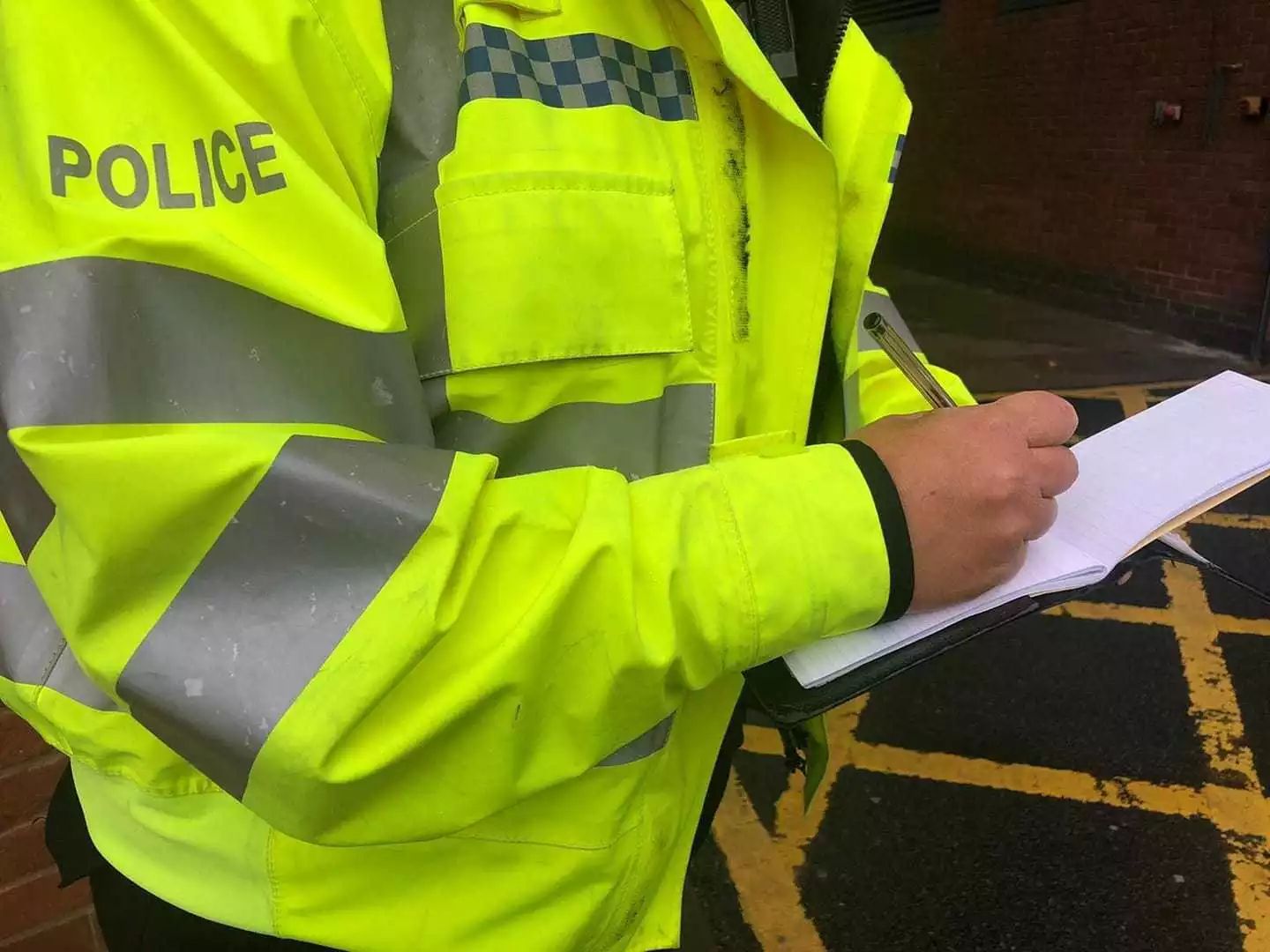




To join in with the discussion please make a donation to The Daily Sceptic.
Profanity and abuse will be removed and may lead to a permanent ban.
The original story was that she described the AfD as a pile of shit.
Her clarification made it even worse, essentially describing a quarter of German voters as flies circling a pile of shit.
This was also widely shared and absorbed as such.
Forget the rest.
How to lose friends and alienate people. Call them flies on a pile of shit. Great work Marie-Agnes.
It’s hardly likely to persuade these ‘flies’ to vote for her. Such utter disdain for the voting public. They deserve to lose.
Communists always behave like this. The German government is essentially a closet communist cabal made up of ex east German commies and younger, new commies. Hitler was a socialist so Germany’s post war trajectory as a socialist hell hole is unsurprising to me. Since Bismarck started state pensions to buy off the socialists in the Parliament, Germany has slowly but certainly headed toward more and more Marxist madness.
I think one of the main reasons the AfD are becoming so popular is because people are completely fed up with the impact of uncontrolled immigration over the years. It’s the regular citizens who feel it and have to live with the effects, after all. Not the ‘elites’ who sit in their ivory towers and never have to experience every day life, rubbing shoulders with the imported riff raff or being victims of migrant crime. I think this article describes the above horrible woman well. These leftards will never acknowledge the evidence which contradicts their delusions;
”There is a camp of those who are clever and cosmopolitan, who to a certain extent embody the higher moral consciousness of society and formulate a socially palatable view on immigration. For example, it claims that only immigration will secure the prosperity of our nation, increase its benefits, ward off harm, and so on. All sorts of magical figures are used to prove all this clearly and objectively.
On the other side is the camp of the ignorant people who do not want to see this. Those who do not have this higher moral consciousness and who are therefore not so insightful in the eyes of the sanctimonious elite. Instead, they ignore the “facts”, oppose progress with hatred and agitation, and are therefore quite rightly politically excluded and marginalized. No one needs to deal with their arguments because they have none.
Beyond the dream world of the former camp, everyone knows what to make of their collective view. The medical assistant in the doctor’s surgery who settles the horrendous sums with the health insurance companies; the employee in the social welfare office who lets his gaze wander over the waiting area; the policeman on the street who tackles the devastation caused by immigration — they all know about the grotesque nonsense that Germany is profiting from immigration.
Pro-immigration advocates dismiss their anecdotal evidence as subjective impressions that are not corroborated by statistics. However, with the new study “Honorable State? Focus migration on the fiscal balance of immigration” by Bernd Raffelhüschen, this is now changing.”
https://rmx.news/economy/migration-does-not-create-prosperity-quite-the-opposite/
Well this is definitely a case of projection.
Is the pile she refers to the German State, its political class or what. Insulting people you want to support you instead of someone else is not a great plan.
Other German politicians have literally called AfD-voters Untermenschen (sub-humans, the supposed Nazi-term for those parts of the population which aren’t really worth having) in the past. Insofar the established German parties go, AfD-supporters have gone over to the dark side and are henceforth enemies to be fought tooth-and-nail. Statements like this are partially meant to emotionalize supporters of these parties in order to motivate them to go voting and partially supposed to prevent losing more of them to the AfD by stigmatizing those already lost in the strongest terms possibly. Lastly, this is also simply a call for vigilante violence against AfD politicians and supporters by the inofficial death squads of the political establishment (this is not a joke — incidences of serious violence against these keep occuring and the establishment politicians not so covertly calling for them know that this is happening and support it, sometimes even openly).
Getting the people to vote for her is possibly not the final solution she has in mind.
At a guess, and looking at the picture I presume she is of the alphabet persuasion.
An honest politician eh? At least she has come clean with her views on her constituents
Either that or she got the memo to come as ‘Geert Wilders’!
Rocking the vampire (Geert Wilders) look.
The FDP stands no chance of winning a mandate in a constituency. FDP-MPs are thus exclusively proportional representation list candidates.
In other words – also rans.
Not really. They usually have between 5% and 10% of the list votes, sometimes falling below 5% and disappearing for a while (parties which get less than 5% of the list vote are legally excluded from parliament) which means they often provide the missing percents to enable someone to form a coalition government. It’s just that they don’t have constituents, not even in the weak German sense. They have an anonymous crowd of supporters distributed all over Germany which often enables them to play a leading role.
Afterthought: This party PR system is really feudal. There’s a small set of political grandees which command huge numbers of individually anonymous and voiceless retainers and the number of retainers is used to rank the grandees who get to make all real political decisions.
These are the same sort of people who warn us that one of the biggest dangers facing us is societal polarisation.
Their lack of self awareness is both amusing and frightening. Frightening because this just isn’t going to end well. Not when it reaches this point.
Their favourite saying is hate won’t win!
The problem with this is that they mean We will castrate your mentally disturbed children. That you hate the idea won’t stop us.
Neo communist spouts insults because it had no solid arguments against AFD.
And the neo-comm is possibly an ex east German communist who pines for the old days, comrades. Wistfully remembering the surveillance, the cancellation and imprisonment of those who did not comply, the kids being brainwashed into dobbing in their parents, the crushing of dissent. Ah the glory days!
What she considers is a “small but important distinction” will be irrelevant to those who support the AfD. She’s just called them flies on a pile of shit.
I think she’s right about “The bigger the pile of shit, the more flies are on it! and she and her “free democratic ” party are the pile of odure that other parties are trying to get rid of.
Deplorables!